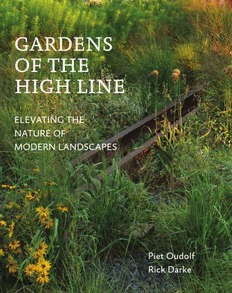
Gardens of the High Line: elevating the nature of modern landscapes PDF
Preview Gardens of the High Line: elevating the nature of modern landscapes
1 GARDENS OF THE HIGH LINE ELEVATING THE NATURE OF MODERN LANDSCAPES Piet Oudolf Rick Darke Timber Press 2 3 CONTENTS 9 PREFACE 11 INTRODUCTION by Robert Hammond 17 ELEVATING THE NATURE OF MODERN LANDSCAPES 40 GARDENS OF THE HIGH LINE 316 ENDNOTES 317 SUGGESTED READING 317 ACKNOWLEDGMENTS 318 INDEX 41 Map 42 GANSEVOORT WOODLAND 91 WASHINGTON GRASSLANDS 122 HUDSON RIVER OVERLOOK 130 SUNDECK & WATER GARDEN 144 NORTHERN SPUR 165 10th AVENUE SQUARE 175 CHELSEA GRASSLANDS 221 Cutback 227 CHELSEA THICKET 245 23rd STREET LAWN & SEATING STEPS 251 MEADOW WALK 259 FLYOVER 273 WILDFLOWER FIELD & RADIAL PLANTINGS 283 RAIL YARDS 295 Gardening 303 Life Line 309 Seasons I feel very strongly in the sort of planting that I do, that you feel the changes all the time. It is a changing beauty: from beauty into beauty. — piet oudolf Chelsea Grasslands, mid-November. 6 7 PREFACE The idea for a book dedicated to the High Line’s gardens originated with co-founder Robert Hammond. Robert’s offer to write the introductory chapter and provide the support of Friends of the High Line staff added immense appeal to the project. Others who’d played essential roles in making and shaping the High Line also offered to share their knowledge and insights. When our friend and graphic designer Lorraine Ferguson agreed to join us, we felt we had the team needed to produce a book that would portray the gardens beautifully and meaningfully. This is the result of that collaboration. For readers just discovering the High Line and others who already know it, this book presents a journey through its gardens in all their seasons, illustrating in great detail their design, evolution, care and context. Though the journey can begin at any of the entry points, the original design intention was that it would begin by ascending the Gansevoort stair at the south end and continue north. We’ve organized this book to match that order. Robert’s introduction is followed by a chapter titled “Elevating the Nature of Modern Landscapes.” Its purpose is to assess and illustrate revolutionary developments in industry, urban aesthetics, horticulture and ecology that led to the creation of an unprecedented urban landscape that has unique global resonance. The next section, “Gardens of the High Line,” makes up the majority of the book. It begins with a map and follows with chapters devoted to each of the High Line’s garden areas. These south-to-north portraits of place are augmented by chapters devoted to the gardens’ care, habitat value and seasonality, titled “Cutback,” “Garden- ing,” “Life Line” and “Seasons.” We believe, as landscape architect James Corner has suggested, that the High Line in its totality is irreproducible: “You just can’t take it anywhere else. Its life, and the energy it has, are drawn in large measure from unique context.”1 At the same time, we know its design ethos, the patterning of its plantings and the enlightened stewardship devoted to them is highly reproducible and broadly worthy of emulation. We hope this book will serve as a beautiful memory of a great place, as guide to the infinite opportunities it presents to practice the art of observation and as an inspiration to all who, publicly or privately, seek to elevate the nature of modern landscapes. Heart-leaved aster (Aster cordifolius), and wild-oat (Chasmanthium latifolium) hairy alumroot (Heuchera macrorhiza thrive between steel rails and riveted ‘Autumn Bride’), Dale’s alumroot railings at a corner of the Northern (Heuchera americana ‘Dale’s Strain’) Spur in late September. 9
